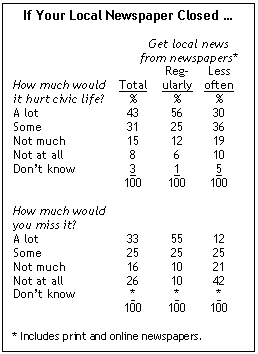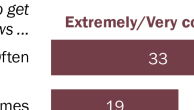Summary of Findings

As many newspapers struggle to stay economically viable, fewer than half of Americans (43%) say that losing their local newspaper would hurt civic life in their community “a lot.” Even fewer (33%) say they would personally miss reading the local newspaper a lot if it were no longer available.
Not unexpectedly, those who get local news regularly from newspapers are much more likely than those who read less often to see the potential shutdown of a local paper as a significant loss. More than half of regular newspaper readers (56%) say that if the local newspaper they read most often no longer published – either in print or online – it would hurt the civic life of the community a lot; an almost identical percentage (55%) says they would personally miss reading the paper a lot if it were no longer available.
The latest weekly News Interest Index, conducted March 6-9 by the Pew Research Center for the People & the Press, finds that the public is continuing to pay close attention to news about the economic crisis and President Obama’s agenda. About a quarter (26%) say the unveiling of Obama’s plan to set aside $630 billion toward overhauling the U.S. health care system was the story they followed most closely last week. Nearly one-in-five (18% each) say their top story was the rising unemployment rate or the major drops in the stock market.
The economic crisis continued to dominate news coverage as well. When combining the ongoing story lines, crisis coverage accounted for 43% of the total newshole, according to a separate analysis by the Pew Research Center’s Project for Excellence in Journalism (PEJ).
The political skirmish over Rush Limbaugh’s role in the Republican Party accounted for 8% of the newshole, making it the second most reported story of the week. But the GOP story appears to have registered less with the public; only 4% say it was the story they followed most closely.
Newspapers’ Struggles

With media coverage of newspaper company bankruptcy filings, threats to close papers, actual shut downs and continuing job cuts, the public is aware of the financial problems. More than half (53%) say they have heard “a lot” about the problems facing newspapers, while 31% say they have heard “a little.” Only 15% say they have heard nothing at all.
When it comes to local news, more people say they get that news from local television stations than any other source. About two-thirds (68%) say they regularly get local news from television reports or television station websites, 48% say they regularly get news from local newspapers in print or online, 34% say they get local news regularly from radio and 31% say they get their local news, more generally, from the internet.
Newspapers have long struggled to attract younger readers. A recent analysis of newspaper readership by Pew Research found that just 27% of Generation Y – those born in 1977 or later – read a newspaper the previous day. That compares with 55% of those in the Silent or Greatest Generations, born prior to 1946. (For more, see “Newspapers Face a Challenging Calculus,” Feb. 26, 2009 Commentary.)

Not unexpectedly, far fewer young people than older Americans say they would miss their local newspaper a lot if it were to close. Less than a quarter of those younger than 40 (23%) say they would miss the local newspaper they read most often a lot if it were to go out of business or shut down. That compares with 33% of those ages 40 to 64 and 55% of those 65 and older.
However, many more of those younger than 40 (41%) say the shutdown of their local newspaper would hurt the civic life in their community a lot. About the same proportion of those ages 40 to 64 (42%) express that view, as do 51% of those 65 and older.
Democrats and independents are more likely to say their communities would be hurt by the loss of the local newspaper than Republicans. About half of Democrats (49%) and 47% of independents say civic life would be hurt “a lot” if the newspaper shut down, compared with 33% of Republicans.
Debating Local Newspaper’s Role

Among those who say the loss of the local daily paper would hurt civic life a lot, three-in-ten say people rely on the paper to know what is going on in their community.
Another 18% say, more generally, that people in their area read the paper. Some 12% note that their community has only one newspaper, while 10% point to their own familiarity or enjoyment of the paper. Another 6% say the paper provides better or more in-depth coverage than does television news, and 6% worry that jobs would be lost if the paper closed.
“I think communities don’t realize how dependent they are. We learn more about ourselves when we learn about our neighbors,’’ one respondent said. “A local newspaper gives a community the opportunity to grieve together; an example is 9/11. It also lets us celebrate the good things — when our teams win, it’s a big deal.”
Many of those who say the closing of the local paper wouldn’t make much, if any, difference in their communities note that there are other news sources available or criticize the newspaper’s quality. About three-in-ten (29%) say there are other ways to get news, including television and radio news and the internet. One-in-five say the quality of the newspaper is poor, while 5% say it is biased. One-in-ten say they don’t read the paper and almost as many (9%) say they don’t think other people read it either.
“There are other forms of communication that are more important and easier to follow. I either go to television or turn on the radio in my car,” said one person who believes the closure of the local paper would make no difference to civic life.
Health Care Reform and Economy Dominate Public Interest

Economic stories continue to dominate public attention and media coverage as news about major drops in the stock market and the continuing loss of American jobs place stress on the U.S. economy. The public’s top story of the week, Obama’s initial plans for overhauling the U.S. health care system, drew considerable public attention but received a smaller share of total press coverage compared with economic news overall.
Barack Obama’s proposal for a $630 billion fund to reform the health care system attracted the very close attention of 41% of Americans. Interest in this was high despite the fact that news organizations devoted only 4% of the total news coverage to this story, according to the PEJ analysis. More Democrats than Republicans were very closely following the president’s health care plans (49% vs. 38%).
Public interest in news about the rising unemployment rate has remained high and generally stable over the last five months. Since early November, roughly four-in-ten Americans have reported following rising unemployment news very closely. Last week, 42% followed the story very closely and, for nearly two-in-ten (18%), this was their top story of the week. According to PEJ, the media devoted 5% of newshole to unemployment.
More than a third (35%) paid very closely attention to recent major drops in the stock market and 18% said this was the single news story they followed more closely than any other. The media devoted 6% of coverage to stock market stories. A plurality of people (45%) with annual family incomes of $75,000 or more paid very close attention to the declining stock market last week, compared with 34% of those with incomes between $30,000 and $75,000, and 23% of those with incomes of less $30,000.

The debate over Rush Limbaugh’s influence over the Republican Party and the verbal sparring between White House officials and Limbaugh himself generated a great deal of news coverage (8% of total news). The Limbaugh story received the greatest attention from cable news networks (17%) and radio outlets (15%), according to PEJ. Public interest, though, was less intense. Just 15% of Americans reported following news about Limbaugh very closely and 4% said this was their top story of the week. More Republicans (21%) than Democrats (11%) very closely followed news about Limbaugh’s influence over the GOP. Pluralities of both independents (47%) and Democrats (44%) reported following this story “not at all closely.”
An arrest warrant for the president of Sudan on charges of war crimes in the Darfur region did not register highly with the American public. Nearly one-in-ten (9%) followed this story very closely and just 1% listed this as their top story.
These findings are based on the most recent installment of the weekly News Interest Index, an ongoing project of the Pew Research Center for the People & the Press. The index, building on the Center’s longstanding research into public attentiveness to major news stories, examines news interest as it relates to the news media’s coverage. The weekly survey is conducted in conjunction with The Project for Excellence in Journalism’s News Coverage Index, which monitors the news reported by major newspaper, television, radio and online news outlets on an ongoing basis. In the most recent week, data relating to news coverage were collected from March 2-8, 2009 and survey data measuring public interest in the top news stories of the week were collected March 6-9, 2009 from a nationally representative sample of 1,001 adults.
About the News Interest Index
The News Interest Index is a weekly survey conducted by the Pew Research Center for the People & the Press aimed at gauging the public’s interest in and reaction to major news events.
This project has been undertaken in conjunction with the Project for Excellence in Journalism’s News Coverage Index, an ongoing content analysis of the news. The News Coverage Index catalogues the news from top news organizations across five major sectors of the media: newspapers, network television, cable television, radio and the internet. Each week (from Sunday through Friday) PEJ compiles this data to identify the top stories for the week. The News Interest Index survey collects data from Friday through Monday to gauge public interest in the most covered stories of the week.
Results for the weekly surveys are based on telephone interviews among a nationwide sample of approximately 1,000 adults, 18 years of age or older, conducted under the direction of ORC (Opinion Research Corporation). For results based on the total sample, one can say with 95% confidence that the error attributable to sampling is plus or minus 3.5 percentage points.
In addition to sampling error, one should bear in mind that question wording and practical difficulties in conducting surveys can introduce error or bias into the findings of opinion polls, and that results based on subgroups will have larger margins of error.
For more information about the Project for Excellence in Journalism’s News Coverage Index, go to www.pewresearch.org/pewresearch-org/journalism.




